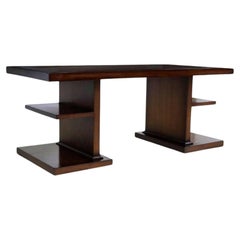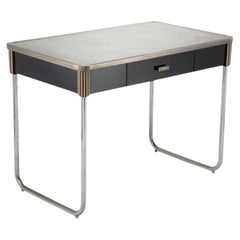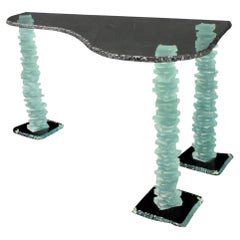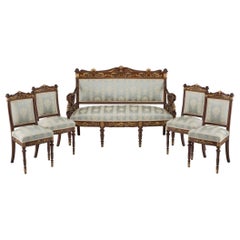Want more images or videos?
Request additional images or videos from the seller
1 of 16
Vienna Art Deco Josef Hoffman Manner Eight-Piece Salon Suite Set
$14,500List Priceper set
About the Item
- Similar to:Josef Hoffmann (Designer)
- Dimensions:Height: 79 in (200.66 cm)Width: 65 in (165.1 cm)Depth: 21 in (53.34 cm)
- Sold As:Set of 8
- Style:Art Deco (Of the Period)
- Materials and Techniques:
- Place of Origin:
- Period:
- Date of Manufacture:circa 1920
- Condition:Wear consistent with age and use. Great original antique condition w/beautifully aged warm mellow patina. Strong, sturdy, structurally sound. Overall very attractive condition; no significant losses/restorations; Wear consistent w/ age & use. Delivered cleaned, waxed,ready for use!
- Seller Location:Forney, TX
- Reference Number:1stDibs: LU5977233495782
About the Seller
4.8
Platinum Seller
Premium sellers with a 4.7+ rating and 24-hour response times
Established in 2013
1stDibs seller since 2021
297 sales on 1stDibs
Authenticity Guarantee
In the unlikely event there’s an issue with an item’s authenticity, contact us within 1 year for a full refund. DetailsMoney-Back Guarantee
If your item is not as described, is damaged in transit, or does not arrive, contact us within 7 days for a full refund. Details24-Hour Cancellation
You have a 24-hour grace period in which to reconsider your purchase, with no questions asked.Vetted Professional Sellers
Our world-class sellers must adhere to strict standards for service and quality, maintaining the integrity of our listings.Price-Match Guarantee
If you find that a seller listed the same item for a lower price elsewhere, we’ll match it.Trusted Global Delivery
Our best-in-class carrier network provides specialized shipping options worldwide, including custom delivery.You May Also Like
French Art Deco Rosewood Desk and Bookcase
Located in West Palm Beach, FL
French Art Deco Rosewood desk and bookcase ,in two-piece.
The tiered bookcase with six half-moon shelves to the left and bronze-mounted c...
Category
Vintage 1930s French Art Deco Bookcases
Materials
Bronze
French Art Deco Ebonized Bookcase (Manner of Pierre Chareau)
By Pierre Chareau
Located in Queens, NY
French Art Deco ebonized 2-section bookcase cabinet with top section having sliding glass and lacquered doors above a base with 2 doors (Manner of Pierre Chareau)
Category
Vintage 1930s French Art Deco Bookcases
Materials
Wood, Glass
1930s Art Deco Bookshelf in the Manner of Gilbert Rohde Refinished
By Gilbert Rohde
Located in Atlanta, GA
1930s Art Deco Bookcase, in the manner of Gilbert Rohde, American, circa 1930s. This came from the same estate as the Gilbert Rohde for Herman Miller desk...
Category
Vintage 1930s American Art Deco Shelves
Materials
Metal
Art Deco Walnut Skyscraper Cabinet / Bookcase in the Manner of Paul T.Frankl
By Paul Frankl
Located in Köln, NW
Art Deco bookcase / cabinet in the style of Paul T. Frankl.
Although the desciption says "In the style of Paul T.Frankl, the object can certainly be attributed to him.
It has the typ...
Category
Vintage 1930s American Art Deco Bookcases
Materials
Brass
$6,233
H 35.44 in W 47.25 in D 11.03 in
Irresistible Pair Art Deco Austria Vienna Large Bookcase Cabinets or Nightstands
Located in Lisse, NL
Top class coromandel Art Deco bookcases, cabinets, nightstands or stands
This early twentieth century and good size Austrian pair of Art Deco bookcases...
Category
Early 20th Century English Vienna Secession Bookcases
Materials
Metal, Brass
$18,050 / set
Free Shipping
H 59.7 in W 14.2 in D 13.9 in
Lovely 2 Piece Flamed Hardwood Open Library Bookcase Part of a Paired Suite
Located in West Sussex, Pulborough
We are delighted to offer for sale this lovely vintage flamed mahogany and hardwood open corner library bookcase which splits into two easy to transport...
Category
20th Century English Victorian Bookcases
Materials
Hardwood
$4,050
H 78.35 in W 49.61 in D 31.3 in
Mid-Century Modern Writing Desk with Bookcase by Fratelli Rizzi, Italy, 1950s
By Ico Parisi
Located in Vigonza, Padua
This exceptional writing desk with integrated bookcase is a fine example of Italian mid-century modern design, crafted by the renowned Fratelli Rizzi workshop in Cantù during the 195...
Category
Mid-20th Century Italian Mid-Century Modern Desks and Writing Tables
Materials
Maple
$6,800
H 81.6 in W 47.2 in D 20.8 in
Mid-19th Century French Louis XIII Heavily Carved Oak Secretary Bookcase Desk
Located in Dallas, TX
Decorate a man's office or study this this stunning Henri II two-piece antique desk cabinet. Crafted in southern France circa 1860 and built of oa...
Category
Antique Mid-19th Century French Louis XIII Bookcases
Materials
Oak
$6,700
H 82 in W 42.25 in D 25.25 in
Important Fully Restored Antique Victorian Bookcase Back Leather Top Kidney Desk
By Gillows of Lancaster & London
Located in West Sussex, Pulborough
We are delighted to offer for sale this Important, fully restored, bookcase back kidney desk attributed to Gillow’s of Lancaster.
This is one of the finest desks I have ever owned, the design was originally made by Gillows of Lancaster, you can see the same desk selling for £100,000-£120,000 with other dealers.
The piece has been on a journey restoration wise, the top was removed and sent to a desk leather specialist in Brighton, they fitted the finest quality, extra large single piece of cattle hide leather, it was then gold leaf embossed with an oversized geometric boarder and secondarily embossed with a rope twist boarder, the top and base were then taken to London where my third generation trained...
Category
Antique 19th Century English Victorian Bookcases
Materials
Leather, Hardwood
$27,461
H 30.52 in W 60.83 in D 31.5 in
Antique English Satinwood Bookcase with Fall Front Desk, Circa 1870-1890
Located in New Orleans, LA
Superb quality antique English satinwood bookcase with fall front desk, Circa 1870-1890.
Category
Antique 19th Century English Bookcases
Materials
Satinwood
$15,800
H 87 in W 37 in D 18.5 in
More From This Seller
View AllCarrocel Interiors Art Deco Style Figured Walnut Office Desk
By Carrocel
Located in Forney, TX
A high quality custom made walnut contemporary writing desk by luxury furniture maker Carrocel Interiors.
Styled in timeless Art Deco Modern tas...
Category
Late 20th Century Art Deco Desks and Writing Tables
Materials
Walnut
1930s Art Deco Raymond Patten Signed Industrial Kitchen Work Table
Located in Forney, TX
A fabulous original American Art Deco industrial Smartline kitchen work table, designed by Raymond Patten (American, 1897-1948), retailed by Internation...
Category
Early 20th Century American Art Deco Industrial and Work Tables
Materials
Chrome, Enamel, Stainless Steel
Rare Modernist Glass Table in the Manner of Danny Lane
By Danny Lane
Located in Forney, TX
A spectacular, Modern sculptured glass table, from the last quarter of the 20th century, in the manner of Danny Lane (United States, b.1955). This stunning table features a floating,...
Category
Late 20th Century Modern Desks and Writing Tables
Materials
Glass
19th Century Russian Empire Period Neoclassical Salon Suite
Located in Forney, TX
A rare and most impressive five-piece Russian neoclassical partial gilt carved wood upholstered salon suite.
Born in the 19th century, during the ...
Category
Antique 19th Century Neoclassical Settees
Materials
Silk, Mahogany, Giltwood
French Art Deco Period Jules Leleu Manner Burlwood Work Table
By Jules Leleu
Located in Forney, TX
A visually striking Art Deco period inlaid burlwood travailleuse / work table, in the manner of iconic French designer Jules Leleu (Paris, France, 1883-1961)
France, circa 1930s, ex...
Category
Vintage 1930s French Art Deco End Tables
Materials
Brass
19th Century Indonesian Lamari Palembang Display Cabinet
Located in Forney, TX
A magnificent, scarce and richly decorated Lamari Palembang three piece cabinet on chest. Exquisitely hand-crafted in the 19th century by highly skilled Chinese or Buddhist artisans ...
Category
Antique 19th Century Bookcases
Materials
Glass, Wood, Giltwood
Recently Viewed
View AllMore Ways To Browse
Three Piece Suite Mid Century
Arts And Crafts Corner Cabinet
Antique Hurst
Art Deco Salon
Ave Maria
Mid Century Campaign Style Desk
Art Deco Cocktail Cabinet Antique Furniture
Josef Hoffmann Cabinet
Lady Barbara
Tanker Desks
Antique Mens Desk With Drawers
Josef Hoffmann Salon Suite
Hoffman Cabinet
George Iii Mahogany Breakfront
Midcentury Desk Bookcase
Painted Black Bookcase
Revolving Bookcase Tables
Antique Gothic Bookcase



